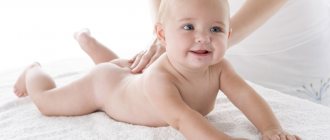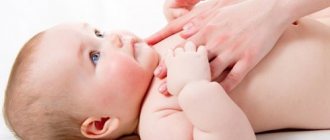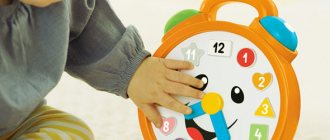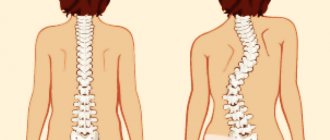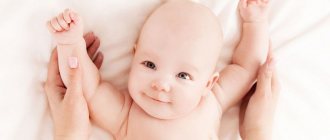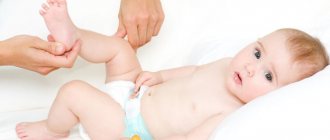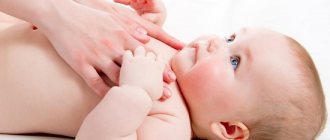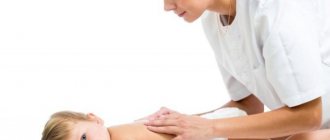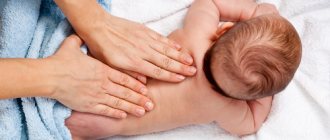Foot massage for children is an effective way to prevent orthopedic problems, normalize muscle tone and form the correct arch of the foot.
Foot massage for children
Massaging a child's foot has its own differences. This is due to the structural features of the foot in childhood: the muscles are too weak and the bones have not yet formed. The foot has no arch and appears completely flat. Massage is indicated from birth. In the first months, children are given only light stroking techniques.
With each month, the massage technique becomes more complicated, the execution time increases, and special exercises and movements are gradually added that form the arch of the foot and help prevent orthopedic problems.
Foot massage technique for children
With one hand you need to fix the child’s foot, with the other hand perform massage movements. Foot massage for children begins with general stroking, involving the area of the ankle joint and lower leg. On the lower leg, grasping stroking and semicircular rubbing are performed. With the help of stroking, the nerve endings of the surface layer of the skin are affected. The technique relaxes and prepares the muscles for rubbing and kneading.
After the preparatory stage, they begin to massage the fingers. Using your fingertips, you should perform semicircular stroking, rubbing and kneading of each of the child’s fingers. You can press your fingers on each side with light movements. After performing the techniques, passive movements are performed in the joints. In each finger, you should carefully perform circular movements, adduction and abduction without sudden movements.
After using the pads of your toes, you should treat the interosseous muscles on the front surface of the foot. Separately, massage the Achilles tendon with pincer-shaped fingers. The younger the child, the less pressure the techniques should be used.
On the sole, techniques are performed with the pads of the fingers. For children older than one year, comb-shaped prims are used. The direction of movement is from toes to heel. You can draw the number “8” and “0”. On the plantar surface of the foot there are a large number of receptors that are responsible for the normal functioning of the systems and organs of children. Therefore, more time should be spent on this part of the foot.
Massage of the ankle joint begins with stroking in circular directions. The anterior and lateral surfaces of the joint are simultaneously treated. Rubbing with skin displacement should be done in a stroke-like manner. The greater the angle between the fingers and the massaged surface, the stronger the pressure. The rubbing technique is combined with circular stroking. The massage ends with passive movements in the joints. Perform flexion and extension, turning the foot outward and inward.
Foot massage for children
Reflex exercises for the foot
Infants are given reflex exercises. To do this, take the child's leg so that the shin is between the thumb and forefinger. With the other hand, actively perform circular movements with the thumb on the arch of the foot, and with the middle and index fingers on the lateral surface.
The next reflex exercise is to press the foot at the base of the toes. In response, the child will reflexively bend his fingers. After this, with a short movement, apply pressure in the area of the Achilles tendon to the heel. This will reflexively stimulate the extension of the foot. The same effect is observed when lightly patting the plantar surface from the heel to the toes. All these techniques form a normal arch of the child’s foot.
Effect of massage
They begin massaging the feet of infants when the baby is 2-2.5 months old, and be sure to take into account the peculiarities of the child’s foot. Newborns have very fragile bones and there is no fatty layer on the foot, so it is prohibited to apply force to the legs.
Light relaxing movements are useful for babies: they evoke positive emotions, relax, and enhance tactile contact with parents.
The purpose and effect of the massage changes with the age of the child: the first three months of work are aimed at relaxing the flexor muscles. The next three months are about normalizing muscle tone and strengthening muscle tissue, then coordinating the work of different muscle groups. From 9 months to one year, the purpose of massage is to prepare the musculoskeletal system for walking.
The beneficial effects of massage are manifested in:
- Development of movement coordination;
- Improving brain function;
- Formation of correct posture;
- Improving breathing and blood circulation, metabolic processes;
- Improving the functioning of the nervous system;
- Reducing the risk of developing rickets;
- Relaxation of the nervous system.
After regular foot massage sessions, babies get up faster and start walking.
There are many nerve endings and biologically active points on the feet, and working them out improves the child’s health. During massage, the digestion process improves, the immune system is strengthened, and blood circulation is activated. Mechanical impact forms the correct silhouette of the foot.
Children continue to receive foot massage even after one year. Daily procedures strengthen the immune system, improve metabolic processes, and prevent curvature of the legs. 4-5 year old children are active and mobile, they need general strengthening procedures. Massage for a five-year-old child is aimed at preventing flat feet, scoliosis, and diseases of the musculoskeletal system.
Read also…. How often should you massage?
Massage for hallux valgus
Some children under the age of 3 have leg deformities. Valgus deformity is a change in the shape of the knee joint, which deforms the shape of the lower extremities. You can notice it when the baby stands so that his heels and knees are connected. When a child’s legs are deformed, the ankles are separated, and if they are close, the knees overlap each other. Simultaneously with the deformation, rickets can also affect the baby. Hypovitaminosis D leads to the development of rickets, which also affects metabolic disorders.
With X-shaped legs, the child is prescribed a course of therapeutic massage. Its goal is to strengthen the muscle tissue of the thighs and inner legs, relaxing the outer side of the leg. During the workout, the back, lower back and buttocks are also involved. Regular sessions allow you to return your knee joints to their normal position.
Leg defects - X- and O-shaped deformation
Indications and contraindications
Massage is an active physiotherapy procedure that is used to prevent orthopedic problems, rickets, diseases of the nervous system, and strengthen the immune system. The procedures are prescribed not only to infants. For children over 1 year of age, home sessions are recommended for:
- Flat feet;
- Improper development of the musculoskeletal system;
- Clubfoot;
- Hypertonicity and hypotonicity of muscle tissue;
- Curvature of the legs and spine;
- High arch of the foot.
Procedures are also carried out for diseases that arise as a result of wearing uncomfortable shoes and lack of movement.
Massaging children's feet is contraindicated if:
- Skin diseases and hypersensitivity;
- Acute stage of rickets;
- Brittle bones;
- High temperature;
- Vomiting;
- Diseases of the blood, kidneys, liver and digestive organs;
- Tuberculosis and diathesis;
- Acute forms of arthritis;
- Diathesis;
- Heart disease;
- Hernias.
If your child has breathing problems, you should consult a doctor before the session.
Mechanism of influence on the body
Massage affects skin receptors, which leads to cutaneous-visceral reflexes. Their essence is that irritation of an area leads to a reflex increase in the activity of internal organs associated with this area. Activation of the nervous system stimulates the activity of the main functions and systems of the child’s body.
Read also…. Massage as a way to combat wrinkles around the eyes
By improving blood circulation, the flow of oxygen, blood and nutrients to organs and tissues increases. Accelerating the movement of lymph leads to a natural and rapid removal of metabolic products from the body.
Mechanical impact on the skin provokes the active production of endorphins and growth hormones. The body relaxes, frees itself from muscle spasms and blocks. Working on the feet also stimulates the development of speech centers.
Adviсe
- If, when performing techniques on the foot, a small child becomes capricious and cries, then you are doing something wrong. It is better to stop the session and calm the child, and then continue. Don’t forget to distract your child: sing, say sentences, turn on pleasant music.
- Professionals do not recommend using special massage products for children. Lubricants not only reduce the sensitivity of mom’s hands, but also have a healing effect. If the baby's skin is too slippery, an inexperienced mother may not determine where to ease the pressure, slow down and linger, and where, on the contrary, to increase the impact. Also, various massage creams, lotions and other products clog skin pores and contribute to overheating.
- A child’s massage must be performed with clean, warm hands without decorations. Nails should be cut short. The room should be ventilated. In winter, it is better to massage near heat sources.
- When performing a foot massage on an infant, only the fingers and hand of the massage therapist should work.
- Medium pressure relieves muscle tension.
- Before you start massaging your child, try the power of the techniques on yourself.
- During the sessions, a prerequisite is the absence of pain.
- Light techniques are performed at the very beginning and at the end of the massage session. They help establish contact with the body at the beginning of the session and relax the muscles. Stroking movements are performed, following one after another.
- Rubbing is used when the child’s foot has already been slightly warmed up by stroking.
- Stretching and compressing the foot - a broad superficial impact without movement is performed with the entire surface of the hand. This exercise shapes the arch of the foot.
Foot massage for children
Problems with baby massage
This technique is not suitable for every child. There are individual physiological needs that require a special approach. The baby needs frequent and thorough foot massage. Having studied the structural features of the leg, parents with the right actions will not cause harm or discomfort to the baby. It is important to measure the time of the procedure. The child will indicate his readiness for a massage by his behavior.
Parents need to accustom their baby to a massage diet. The baby will get used to the routine, perceiving the massage as an obligatory attribute. Starting from five or six months, depending on individual factors, the foot acquires a structure, arrangement of muscles and bones that will not change throughout a person’s life. If the foot changes, it means that initially there were deviations from the norm that required treatment.
The child needs to have a daily massage. Remember that the child may experience different feelings during the procedure. Try to entice him with exciting and interesting things. Massage at an early age helps to avoid serious foot diseases, including club feet.
Contraindications for foot massage
There are temporary and absolute contraindications to massage in children.
Temporary contraindications:
- Fever
- Rickets in the acute stage
- Diseases that are accompanied by brittle bones
- Increased skin sensitivity
- Child's restlessness, crying, or reluctance to massage
- Kidney and liver diseases
- Severe malnutrition (weight loss)
- Dysfunction of the gastrointestinal tract
- Vomit
- Skin diseases
In case of diseases of the cardiovascular and respiratory systems, the question of whether to massage the child’s feet is decided by the doctor.
Absolute contraindications:
- Skin irritation: rash, inflammation, fungal infections
- Injuries: burns, severe bruises, dislocations, fractures
- Infectious diseases
- Blood diseases
- Tumors
Features of baby massage and a little history
Types of massage have individual characteristics. The differences between procedures in children and adults are clearly delineated. Let's try to find out the signs by briefly studying the history of massage.
Massage was invented in Ancient India. Initially, the method of influence was called religious relaxation of the Indian soul. It represented a special ritual among Indian tribes that brought pleasure. Indians did not suffer from clubfoot disease. Travelers and pioneers of India began to notice the procedure of massaging the feet, bringing the idea to their country.
In Russia, people learned about massage relatively recently and simply called it relaxing procedures. In the nineteenth century, Russians adopted the word “massage” from French ambassadors. After just a few months, massage spread widely. Only imperial officials and nobles could afford such procedures. Massage played the role of a privilege. It resulted in the creation of many jobs and caused a surge in new professions. The courtiers provided massages to feudal lords and their master's children under one year of age for a fee as part of their general salary.
Now, when you come to any beauty salon, you can use the services of professional massage therapists. However, professionals for adults do not know the needs of the baby and can harm little legs if there is no special license or the trainer has not been trained. Parents are quite capable of giving their child a massage on their own.
The procedure is carried out correctly. Main features of baby massage:
- Don't put too much pressure on your leg. Pressure injures the structure and rubs the muscles of the feet.
- There is no need to apply too rich and nourishing cream. The product will make the baby's skin rough and add an oily shine. It is better to use a moisturizer. Products for massaging children's feet are purchased in pharmacies.
Massage cream - Too much massage crushes small bones, causing clubfoot. A long massage will not become a child’s favorite pastime. Morning and evening are suitable times for the procedure.
The listed features are suitable for any baby. Depends partly on age. The structure of children's feet is different; it is necessary to adapt to the features of the anatomy. Frequent short massages will make walking easier and help strengthen your leg and muscles.
How massage can help
Massage has a beneficial effect on the child's body both physically and mentally. From birth, babies recognize emotions through touch. They feel tenderness and love very sensitively. Therefore, a massage given by beloved parents is of great importance. And the more often they stroke him and touch him, the more secure he will feel.
Massage improves blood circulation, intestinal function, brain, heart, lungs, and helps supply muscles with oxygen.
After good and correct sessions, the little one will begin to crawl, sit, walk and stand on time. He will talk, sleep and eat well in the future. It is obvious that infant massage is necessary for health and development. The first years of a little person's life are very important. They are a stage in the formation of the skills of his movements.
